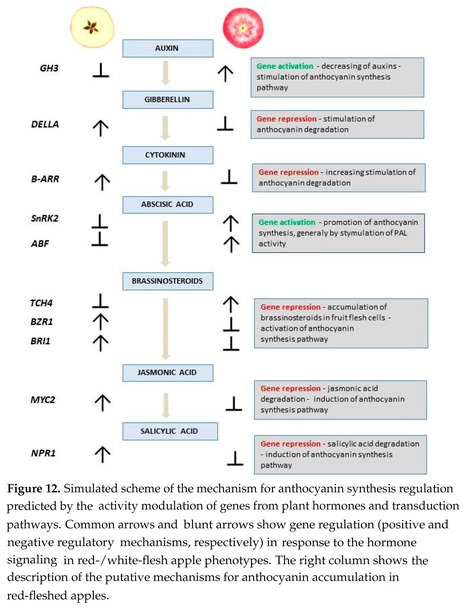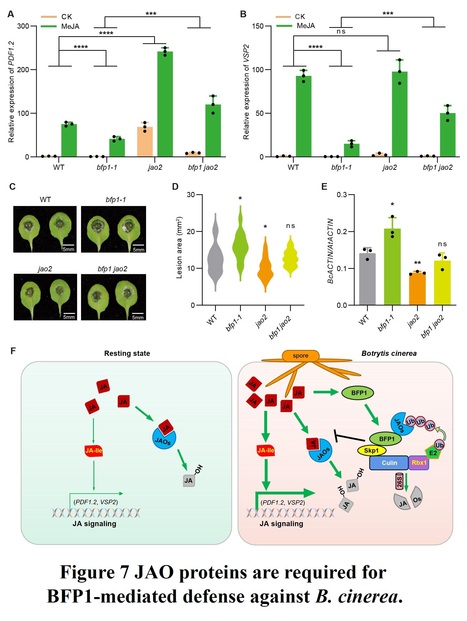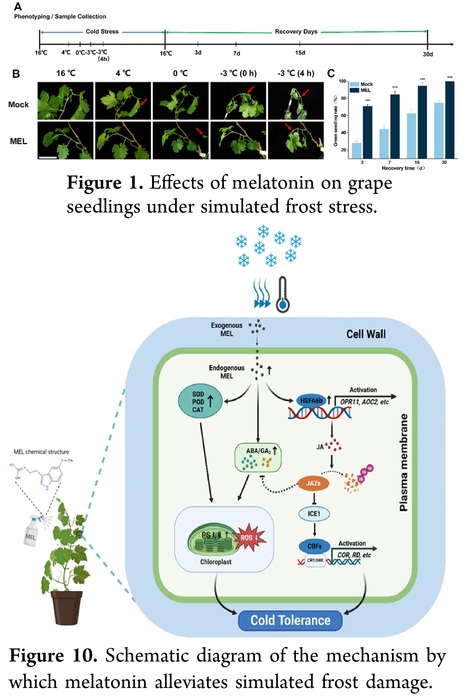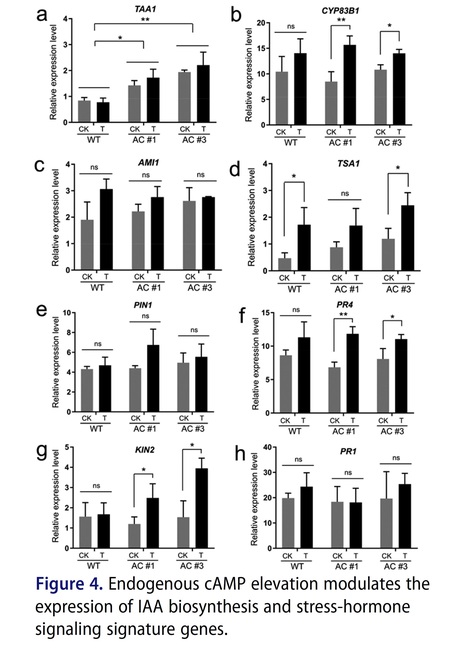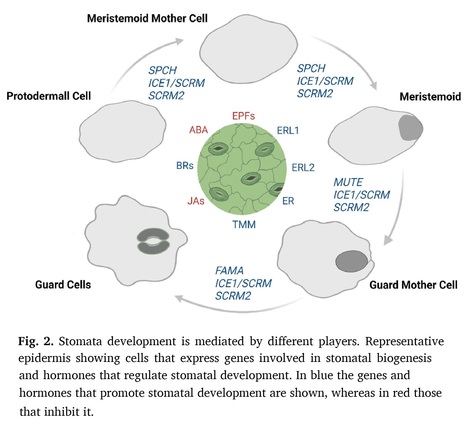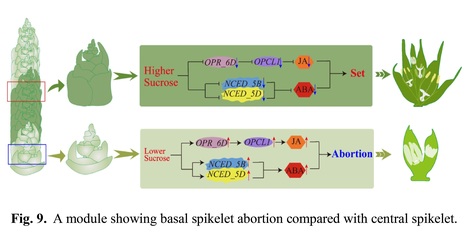 Your new post is loading...
 Your new post is loading...
Authors: Sylwia Keller-Przybylkowicz, Michal Oskiera , Xueqing Liu, Laiqing Song, Lingling Zhao, Xiaoyun Du, Dorota Kruczynska, Agnieszka Walencik, Norbert Kowara and Grzegorz Bartoszewski.
International Journal of Molecular Sciences (2024)
Abstract: "The red flesh coloration of apples is a result of a biochemical pathway involved in the biosynthesis of anthocyanins and anthocyanidins. Based on apple genome analysis, a high number of regulatory genes, mainly transcription factors such as MYB, which are components of regulatory complex MYB-bHLH-WD40, and several structural genes (PAL, 4CL, CHS, CHI, F3H, DFR, ANS, UFGT) involved in anthocyanin biosynthesis, have been identified. In this study, we investigated novel genes related to the red-flesh apple phenotype. These genes could be deemed molecular markers for the early selection of new apple cultivars. Based on a comparative transcriptome analysis of apples with different fruit-flesh coloration, we successfully identified and characterized ten potential genes from the plant hormone transduction pathway of auxin (GH3); cytokinins (B-ARR); gibberellins (DELLA); abscisic acid (SnRK2 and ABF); brassinosteroids (BRI1, BZR1 and TCH4); jasmonic acid (MYC2); and salicylic acid (NPR1). An analysis of expression profiles was performed in immature and ripe fruits of red-fleshed cultivars. We have uncovered genes mediating the regulation of abscisic acid, salicylic acid, cytokinin, and jasmonic acid signaling and described their role in anthocyanin biosynthesis, accumulation, and degradation. The presented results underline the relationship between genes from the hormone signal transduction pathway and UFGT genes, which are directly responsible for anthocyanin color transformation as well as anthocyanin accumulation during apple-fruit ripening."
Authors: Mingfeng Zhang, Xiao Luo, Wei He, Min Zhang, Zhirong Peng, Huafeng Deng and Junjie Xing.
Plants (2024)
Abstract: "JAZ proteins function as transcriptional regulators that form a jasmonic acid–isoleucine (JA-Ile) receptor complex with coronatine insensitive 1 (COI1) and regulate plant growth and development. These proteins also act as key mediators in signal transduction pathways that activate the defense-related genes. Herein, the role of OsJAZ4 in rice blast resistance, a severe disease, was examined. The mutation of OsJAZ4 revealed its significance in Magnaporthe oryzae (M. oryzae) resistance and the seed setting rate in rice. In addition, weaker M. oryzae-induced ROS production and expression of the defense genes OsO4g10010, OsWRKY45, OsNAC4, and OsPR3 was observed in osjaz4 compared to Nipponbare (NPB); also, the jasmonic acid (JA) and gibberellin4 (GA4) content was significantly lower in osjaz4 than in NPB. Moreover, osjaz4 exhibited a phenotype featuring a reduced seed setting rate. These observations highlight the involvement of OsJAZ4 in the regulation of JA and GA4 content, playing a positive role in regulating the rice blast resistance and seed setting rate."
Authors: Yuki Furuta, Haruka Yamamoto, Takeshi Hirakawa, Akira Uemura, Margaret Anne Pelayo, Hideaki Iimura, Naoya Katagiri, Noriko Takeda-Kamiya, Kie Kumaishi, Makoto Shirakawa, Sumie Ishiguro, Yasunori Ichihashi, Takamasa Suzuki, Tatsuaki Goh, Kiminori Toyooka, Toshiro Ito & Nobutoshi Yamaguchi
Nature Communications (2024)
Editor's view: In angiosperms, petal abscission is crucial for reproductive success and seed dispersion. However, the regulation of this abscission remains unclear. Here, the authors identify a process of petal abscission regulated by jasmonic acid via autophagy at the base of Arabidopsis petals.
Abstract: "In angiosperms, the transition from floral-organ maintenance to abscission determines reproductive success and seed dispersion. For petal abscission, cell-fate decisions specifically at the petal-cell base are more important than organ-level senescence or cell death in petals. However, how this transition is regulated remains unclear. Here, we identify a jasmonic acid (JA)-regulated chromatin-state switch at the base of Arabidopsis petals that directs local cell-fate determination via autophagy. During petal maintenance, co-repressors of JA signaling accumulate at the base of petals to block MYC activity, leading to lower levels of ROS. JA acts as an airborne signaling molecule transmitted from stamens to petals, accumulating primarily in petal bases to trigger chromatin remodeling. This allows MYC transcription factors to promote chromatin accessibility for downstream targets, including NAC DOMAIN-CONTAINING PROTEIN102 (ANAC102). ANAC102 accumulates specifically at the petal base prior to abscission and triggers ROS accumulation and cell death via AUTOPHAGY-RELATED GENEs induction. Developmentally induced autophagy at the petal base causes maturation, vacuolar delivery, and breakdown of autophagosomes for terminal cell differentiation. Dynamic changes in vesicles and cytoplasmic components in the vacuole occur in many plants, suggesting JA–NAC-mediated local cell-fate determination by autophagy may be conserved in angiosperms."
Authors: Yuqing He, Yao Zhao, Jitao Hu, Lanlan Wang, Linying Li, Xueying Zhang, Zhongjing Zhou, Lili Chen, Hua Wang, Jiaoyu Wang and Gaojie Hong.
Molecular Plant (2024)
Abstract: "The growth-promoting hormones brassinosteroids (BRs) and their key signaling component BZR1 play a vital role in balancing normal growth and defense reactions. Here, we discovered that BRs and OsBZR1 upregulated sakuranetin accumulation and conferred basal defense against Magnaporthe oryzae infection under normal conditions. Resource shortages, including phosphate (Pi) deficiency, potentially disrupt this growth–defense balance. OsSPX1 and OsSPX2 have been reported to sense Pi concentration and interact with the Pi signal mediator OsPHR2, thus regulating Pi starvation responses. In this study, we discovered that OsSPX1/2 interacts with OsBZR1 in both Pi-sufficient and Pi-deficient conditions, inhibiting BR-responsive genes. When Pi is sufficient, OsSPX1/2 is captured by OsPHR2, enabling most of OsBZR1 to promote plant growth and maintain basal resistance. In response to Pi starvation, more OsSPX1/2 is released from OsPHR2 to inhibit OsBZR1 activity, resulting in slower growth. Collectively, our study reveals that the OsBZR1–SPX1/2 module balances the plant growth–immunity trade-off in response to Pi availability."
Authors: Shai Morin, Peter W. Atkinson and Linda L. Walling.
Annual Review of Entomology (2024)
Abstract: "The rapid advances in available transcriptomic and genomic data and our understanding of the physiology and biochemistry of whitefly–plant interactions have allowed us to gain new and significant insights into the biology of whiteflies and their successful adaptation to host plants. In this review, we provide a comprehensive overview of the mechanisms that whiteflies have evolved to overcome the challenges of feeding on phloem sap. We also highlight the evolution and functions of gene families involved in host perception, evaluation, and manipulation; primary metabolism; and metabolite detoxification. We discuss the emerging themes in plant immunity to whiteflies, focusing on whitefly effectors and their sites of action in plant defense–signaling pathways. We conclude with a discussion of advances in the genetic manipulation of whiteflies and the potential that they hold for exploring the interactions between whiteflies and their host plants, as well as the development of novel strategies for the genetic control of whiteflies."
Authors: Jian-Ping An, Rui-Rui Xu, Xiao-Na Wang, Xiao-Wei Zhang, Chun-Xiang You and Yuepeng Han.
Journal of Integrative Plant Biology (2024)
Abstract: "Anthocyanins are secondary metabolites induced by environmental stimuli and developmental signals. The positive regulators of anthocyanin biosynthesis have been reported, whereas the anthocyanin repressors have been neglected. Although the signal transduction pathways of gibberellin (GA) and jasmonic acid (JA) and their regulation of anthocyanin biosynthesis have been investigated, the cross-talk between GA and JA and the antagonistic mechanism of regulating anthocyanin biosynthesis remain to be investigated. In this study, we identified the anthocyanin repressor MdbHLH162 in apple and revealed its molecular mechanism of regulating anthocyanin biosynthesis by integrating the GA and JA signals. MdbHLH162 exerted passive repression by interacting with MdbHLH3 and MdbHLH33, which are two recognized positive regulators of anthocyanin biosynthesis. MdbHLH162 negatively regulated anthocyanin biosynthesis by disrupting the formation of the anthocyanin-activated MdMYB1-MdbHLH3/33 complexes and weakening transcriptional activation of the anthocyanin biosynthetic genes MdDFR and MdUF3GT by MdbHLH3 and MdbHLH33. The GA repressor MdRGL2a antagonized MdbHLH162-mediated inhibition of anthocyanins by sequestering MdbHLH162 from the MdbHLH162-MdbHLH3/33 complex. The JA repressors MdJAZ1 and MdJAZ2 interfered with the antagonistic regulation of MdbHLH162 by MdRGL2a by titrating the formation of the MdRGL2a-MdbHLH162 complex. Our findings reveal that MdbHLH162 integrates the GA and JA signals to negatively regulate anthocyanin biosynthesis. This study provides new information for discovering more anthocyanin biosynthesis repressors and explores the cross-talk between hormone signals."
Authors: Deepika Mittal, Janesh Kumar Gautam, Mahendra Varma, Amrutha Laie, Shruti Mishra, Smrutisanjita Behera and Jyothilakshmi Vadassery.
Plant, Cell & Environment (2024)
Abstract: "Jasmonic acid-isoleucine (JA-Ile) is a plant defence hormone whose cellular levels are elevated upon herbivory and regulate defence signalling. Despite their pivotal role, our understanding of the rapid cellular perception of bioactive JA-Ile is limited. This study identifies cell type-specific JA-Ile-induced Ca2+ signal and its role in self-amplification and plant elicitor peptide receptor (PEPR)-mediated signalling. Using the Ca2+ reporter, R-GECO1 in Arabidopsis, we have characterized a monophasic and sustained JA-Ile-dependent Ca2+ signature in leaf epidermal cells. The rapid Ca2+ signal is independent of positive feedback by the JA-Ile receptor, COI1 and the transporter, JAT1. Microarray analysis identified up-regulation of receptors, PEPR1 and PEPR2 upon JA-Ile treatment. The pepr1 pepr2 double mutant in R-GECO1 background exhibits impaired external JA-Ile induced Ca2+cyt elevation and impacts the canonical JA-Ile responsive genes. JA responsive transcription factor, MYC2 binds to the G-Box motif of PEPR1 and PEPR2 promoter and activates their expression upon JA-Ile treatment and in myc2 mutant, this is reduced. External JA-Ile amplifies AtPep-PEPR pathway by increasing the AtPep precursor, PROPEP expression. Our work shows a previously unknown non-canonical PEPR-JA-Ile-Ca2+-MYC2 signalling module through which plants sense JA-Ile rapidly to amplify both AtPep-PEPR and jasmonate signalling in undamaged cells."
Authors: Chengfeng Xue, Meng Zhang and Ruifeng Yao.
Advanced Agrochem (2024)
Highlights: • We made a commentary on a paper published in Nature Synthesis. • The plant-derived jasmonate biosynthetic pathway was refactored into yeast. • This work paves the way toward large-scale biosynthesis of phytohormone in the future.
Abstract: "The plant defense hormone jasmonates not only play important roles in plant growth, development, and resistance, but also hold promise for bringing new strategies in plant protection and cancer therapy. Recently, de novo biosynthesis of natural and unnatural jasmonates in refactored yeast with integration of 15 heterologous genes and 3 native genes deleted was reported. Here, we highlight the feasible and sustainable platform to efficiently produce jasmonates, which would benefit both agriculture and human health."
Authors: Min Zhang, Weiwei Li, Tingyu Zhang, Yueyan Liu and Lijing Liu.
Molecular Plant (2024)
Abstract: "Jasmonic acid (JA) is a crucial phytohormone that regulates plant immunity. The endogenous JA level is determined by the rates of its biosynthesis and catabolism in plants. To date, the activation of JA biosynthesis has been well documented; however, how plants repress JA catabolism upon pathogen infection remains elusive. Here, we identified Botrytis cinerea-induced F-box protein 1 (BFP1) in Arabidopsis. The expression of BFP1 was induced by B. cinerea in a JA signaling dependent manner, and BFP1 protein was critical for plant defense against B. cinerea and plant response to JA. Additionally, BFP1 overexpression increased plant defenses against broad-spectrum pathogens without fitness costs. Further experiments demonstrated that BFP1 interacts with and mediates the ubiquitination and degradation of jasmonic acid oxidases (JAOs, also known as jasmonate-induced oxygenases, JOXs), the enzymes that hydroxylate JA to 12OH-JA. Consistently, the accumulation of JA and 12OH-JA was regulated by BFP1 during B. cinerea infection. Moreover, mutation of JAO2 complemented the phenotypic effects of the bfp1 mutant. Collectively, our results unveil an undiscovered strategy to enhance plant immunity by suppressing the catabolism of immune-related hormone."
Authors: Junduo Li, Kai Lv, Jieping Wu, Yaping Xie, Junxia Zhang, Ningbo Zhang and Weirong Xu.
Journal of Agricultural and Food Chemistry (2023)
Abstract: "Melatonin (MEL) is an antioxidant molecule that enhances plant tolerance to environmental stress. However, the mechanisms by which MEL regulates cold signaling pathways in grapes under cold stress remain elusive. Here, we investigated the physiological and transcriptomic changes in grape seedlings treated with exogenous MEL to determine their protective role under cold stress. Results showed that 150 μM MEL effectively attenuated cold-induced cell damage by reducing reactive oxygen species (ROS) and preserving the chloroplast structure and function. MEL also inhibited tannin degradation, which contributed to its protective effect. Exogenous MEL promoted the synthesis of endogenous MEL, abscisic acid, auxin, and cytokinin while inhibiting gibberellin. Transcriptomic profiling revealed 776 differentially expressed transcripts in MEL-treated samples compared to controls. Functional analysis of a candidate hub gene, VvHSFA6b, showed that its overexpression in grape calli enhances cold tolerance by activating jasmonic acid synthesis pathway genes, promoting JA accumulation, and inhibiting JAZ-repressed transcription factors."
Authors: Md Ibrahim Khalil, Md Mahmudul Hassan, Swadesh Chandra Samanta, Abul Kashem Chowdhury, Md Zahid Hassan, Nasar Uddin Ahmed, Uzzal Somaddar, Sharmistha Ghosal, Arif Hasan Khan Robin, Ujjal Kumar Nath, Mohammad Golam Mostofa, David J. Burritt, Chien Van Ha, Aarti Gupta, Lam-Son Phan Tran and Gopal Saha.
Plant Physiology and Biochemistry (2024)
Highlights • Rice plants having SUB1A-1 endure submergence through a quiescence strategy. • SUB1A-1 mediates inhibition of levels and signaling of ethylene, gibberellin and auxin. • SUB1A-1 increases brassinosteroid biosynthesis and signaling, and JA responsiveness. • SUB1A-1 activates leaf gas film formation and reduces carbohydrate catabolism. • Submergence-tolerant wild rice genotypes lack SUB1A.
Abstract: "The world's low-lying rice (Oryza sativa) cultivation areas have been suffering from the threats of submergence or flash flooding due to global warming. Rice plants manifest a variety of physiological and morphological changes to cope with hypoxia and underwater adversities, including lowering carbohydrate consumption, inhibiting shoot elongation, and forming thicker leaf gas film during submergence. Functional studies have revealed that submergence tolerance in rice is mainly determined by an ethylene response factor (ERF) transcription factor-encoding gene, namely SUBMERGENCE 1A-1 (SUB1A-1) located in the SUB1 quantitative trait locus. The SUB1A-1-dependent submergence tolerance is manifested through hormones such as ethylene, gibberellic acid, brassinosteroid, auxin and jasmonic acid. Considerable progress has been made toward the introduction of SUB1A-1 into rice varieties through a conventional marker-assisted backcrossing strategy. Here, we review the recent advances in the physiological, biochemical and molecular dynamics of rice submergence tolerance mediated by the ‘quiescence strategy’. Thus, the present review aims to provide researchers with insights into the genetics of rice submergence tolerance and future perspectives for designing submergence-resilient plants for sustainable agriculture under the uncertainties of climate change."
Authors: Xuxu Wang, Jia Wei, Jiahao Wu, Baojing Shi, Peihui Wang, Ahmed Alabd, Duanni Wang, Yuhao Gao, Junbei Ni, Songling Bai and Yuanwen Teng.
Plant Physiology (2024)
Abstract: "Bud dormancy is an important physiological process during winter. Its release requires a certain period of chilling. In pear (Pyrus pyrifolia), the abscisic acid (ABA)-induced expression of DORMANCY-ASSOCIATED MADS-box (DAM) genes represses bud break, whereas exogenous gibberellin (GA) promotes dormancy release. However, with the exception of ABA and GA, the regulatory effects of phytohormones on dormancy remain largely uncharacterized. In this study, we confirmed brassinosteroids (BRs) and jasmonic acid (JA) contribute to pear bud dormancy release. If chilling accumulation is insufficient, both 24-epibrassinolide (EBR) and methyl jasmonic acid (MeJA) can promote pear bud break, implying they positively regulate dormancy release. BRASSINAZOLE RESISTANT 2 (BZR2), which is a BR-responsive transcription factor, inhibited PpyDAM3 expression and accelerated pear bud break. The transient overexpression of PpyBZR2 increased endogenous GA, JA, and JA-Ile levels. In addition, the direct interaction between PpyBZR2 and MYELOCYTOMATOSIS 2 (PpyMYC2) enhanced the PpyMYC2-mediated activation of Gibberellin 20-oxidase genes PpyGA20OX1L1 and PpyGA20OX2L2 transcription, thereby increasing GA3 contents and accelerating pear bud dormancy release. Interestingly, treatment with 5 µM MeJA increased the bud break rate, while also enhancing PpyMYC2-activated PpyGA20OX expression and increasing GA3,4 contents. The 100 μM MeJA treatment decreased the PpyMYC2-mediated activation of the PpyGA20OX1L1 and PpyGA20OX2L2 promoters and suppressed the inhibitory effect of PpyBZR2 on PpyDAM3 transcription, ultimately inhibiting pear bud break. In summary, our data provide insights into the crosstalk between the BR and JA signaling pathways that regulate the BZR2/MYC2-mediated pathway in the pear dormancy release process."
Authors: Yun-Jing Bao, Jia-Xu Chen, Youjun Zhang, Alisdair R. Fernie, Jianhua Zhang, Bao-Xing Huang, Fu-Yuan Zhu and Fu-Liang Cao.
Advanced Agrochem (2024)
Highlights: • This review addresses the multiple roles served by JA-involved regulatory networks in different woody species, which have similar properties and differential regulation within their herbaceous counterparts, especially focusing on developmental growth. • The potential role of AS a regulatory mechanism of JA modulation, which is concerned with plant development and stress responses. The utilization of proteogenomic analysis would further advance our standing of JA-mediated AS regulation and elucidate the specific mechanisms in woody plants.
Abstract: "Jasmonic acid is a crucial phytohormone that plays a pivotal role, serving as a regulator to balancing plant development and resistance. However, there are analogous and distinctive characteristics exhibited in JA biosynthesis, perception, and signal transduction pathways in both herbaceous and woody plants. Moreover, the majority of research subjects have predominantly focused on the function of JA in model or herbaceous plants. Consequently, there is a significant paucity of studies investigating JA regulation networks in woody plants, particularly concerning post-transcriptional regulatory events such as alternative splicing (AS). This review article aims to conduct a comprehensive summary of advancements that JA signals regulate plant development across various woody species, comparing the analogous features and regulatory differences to herbaceous counterparts. In addition, we summarized the involvement of AS events including splicing factor (SF) and transcripts in the JA regulatory network, highlighting the effectiveness of high-throughput proteogenomic methods. A better understanding of the JA signaling pathway in woody plants has pivotal implications for forestry production, including optimizing plant management and enhancing secondary metabolite production."
|
Authors: Tianming Li, Wenjing Jia, Song Peng, Yanhui Guo, Jinrui Liu, Xue Zhang, Panyu Li, Hanfeng Zhang and Ruqiang Xu.
Plant Signaling & Behavior (2024)
Abstract: "In higher plants, the regulatory roles of cAMP (cyclic adenosine 3′,5′-monophosphate) signaling remain elusive until now. Cellular cAMP levels are generally much lower in higher plants than in animals and transiently elevated for triggering downstream signaling events. Moreover, plant adenylate cyclase (AC) activities are found in different moonlighting multifunctional proteins, which may pose additional complications in distinguishing a specific signaling role for cAMP. Here, we have developed rapeseed (Brassica napus L.) transgenic plants that overexpress an inducible plant-origin AC activity for generating high AC levels much like that in animal cells, which served the genetic model disturbing native cAMP signaling as a whole in plants. We found that overexpression of the soluble AC activity had significant impacts on the contents of indole-3-acetic acid (IAA) and stress phytohormones, i.e. jasmonic acid (JA), abscisic acid (ABA), and salicylic acid (SA) in the transgenic plants. Acute induction of the AC activity caused IAA overaccumulation, and upregulation of TAA1 and CYP83B1 in the IAA biosynthesis pathways, but also simultaneously the hyper-induction of PR4 and KIN2 expression indicating activation of JA and ABA signaling pathways. We observed typical overgrowth phenotypes related to IAA excess in the transgenic plants, including significant increases in plant height, internode length, width of leaf blade, petiole length, root length, and fresh shoot biomass, as well as the precocious seed development, as compared to wild-type plants. In addition, we identified a set of 1465 cAMP-responsive genes (CRGs), which are most significantly enriched in plant hormone signal transduction pathway, and function mainly in relevance to hormonal, abiotic and biotic stress responses, as well as growth and development. Collectively, our results support that cAMP elevation impacts phytohormone homeostasis and signaling, and modulates plant growth and development. We proposed that cAMP signaling may be critical in configuring the coordinated regulation of growth and development in higher plants."
Authors: Zhangshuai Yang, Guanyu Liang, Chenxu Liu, Zhaohui Chu and Ning Li.
Plant Cell Reports (2024)
Key message The maize F-box protein ZmFBL41 targets abscisic acid synthase 9-cis-epoxycarotenoid dioxygenase 6 for degradation, and this regulatory module is exploited by Rhizoctonia solani to promote infection.
Abstract: "F-box proteins are crucial regulators of plant growth, development, and responses to abiotic and biotic stresses. Previous research identified the F-box gene ZmFBL41 as a negative regulator of maize (Zea mays) defenses against Rhizoctonia solani. However, the precise mechanisms by which F-box proteins mediate resistance to R. solani remain poorly understood. In this study, we show that ZmFBL41 interacts with an abscisic acid (ABA) synthase, 9-cis-epoxycarotenoid dioxygenase 6 (ZmNCED6), promoting its degradation via the ubiquitination pathway. We discovered that the ectopic overexpression of ZmNCED6 in rice (Oryza sativa) inhibited R. solani infection by activating stomatal closure, callose deposition, and jasmonic acid (JA) biosynthesis, indicating that ZmNCED6 enhances plant immunity against R. solani. Natural variation at ZmFBL41 across different maize haplotypes did not affect the ZmFBL41–ZmNCED6 interaction. These findings suggest that ZmFBL41 targets ZmNCED6 for degradation, leading to a decrease in ABA levels in maize, in turn, inhibiting ABA-mediated disease resistance pathways, such as stomatal closure, callose deposition, and JA biosynthesis, ultimately facilitating R. solani infection."
Authors: Qiu Yang, Yong Wang, Guilan Zhang, Yunxing Wang, Jingyong Huang, Youwei Feng, Yan Li, Jun Jiang and Yanjie Zhang.
Plant Science (2024)
Highlights • Overexpression of a BR inactivating enzyme gene GhPAG1 severely retarded eggplant growth and development. • BR deficiency impacts eggplant fruit development and anthocyanin coloration mainly by altering endogenous hormone homeostasis. • It was suggested that BR probably regulates eggplant fruit development and anthocyanin coloration via auxin and jasmonic acid signaling pathway, respectively.
Abstract: "Brassinosteroids (BRs) function importantly in plant growth and development, but the roles in regulating fruit development and anthocyanin pigmentation remain unclear. Eggplant (Solanum melongena L.) is an important Solanaceae vegetable crop rich in anthocyanins. The fruit size and coloration are important agronomic traits for eggplant breeding. In this study, transgenic eggplant exhibiting endogenous BRs deficiency was created by overexpressing a heterologous BRs-inactivating enzyme gene GhPAG1 driven by CaMV 35 S promoter. 35 S::GhPAG1 eggplant exhibited severe dwarfism, reduced fruit size, and less anthocyanin accumulation. Microscopic observation showed that the cell size of 35 S::GhPAG1 eggplant was significantly reduced compared to WT. Furthermore, the levels of IAA, ME-IAA, and active JAs (JA, JA-ILE, and H2JA) all decreased in 35 S::GhPAG1 eggplant fruit. RNA-Seq analyses showed a decrease in the expression of genes involved in cell elongation, auxin signaling, and JA signaling. Besides, overexpression of GhPAG1 significantly downregulated anthocyanin biosynthetic genes and associated transcription regulators. Altogether, these results strongly suggest that endogenous brassinosteroid deficiency arising from GhPAG1 overexpression impacts eggplant fruit development and anthocyanin coloration mainly by altering hormone homeostasis."
Authors: Pratibha Demiwal, Sajad Un Nabi, Javid Iqbal Mir, Mahendra K. Verma, Shri Ram Yadav, Partha Roy and Debabrata Sircar.
Plant Physiology and Biochemistry (2024)
Highlights: • By applying MeJA to Red Delicious (RD) apples, scab resistance was improved. • MeJA treatment increases H2O2 and decreases MDA levels in infected RD leaves. • MeJA increases phenolic compound levels and PAL and SOD enzyme activities. • H2O2 and ROS act as signal molecules for triggering MeJA-induced scab resistance. • MeJA treatment could be used as a strategy to control apple scab.
Abstract: "Apple (Malus domestica) is an economically important rosaceous fruit crop grown at temperate climate zones. Nevertheless, its production is severely affected by scab disease caused by the ascomycetous fungus Venturia inaequalis (VI). Methyl jasmonate (MeJA) is a stress induced plant hormone, shown to induce resistance against wide range of pathogens. The current study investigated the role of MeJA in promoting scab tolerance in susceptible apple varieties through exogenous application of optimized (100 μM) MeJA concentration, followed by VI infection. According to our analysis, applying MeJA exogenously onto leaf surfaces resulted in increased membrane stability and decreased malondialdehyde levels in Red Delicious, suggesting that MeJA is capable of protecting tissues against oxidative damage through its role in restoring membrane stability. In addition, the changes in the levels of key antioxidative enzymes and reactive oxygen species (ROS) showed that exogenous MeJA maintains ROS homeostasis as well. Higher phenylalanine ammonia-lyase activity and increased accumulation of phenylpropanoids in MeJA-treated VI-infected plants indicated the MeJA reprogrammed phenylpropanoid biosynthesis pathway for scab tolerance. Our study of scab tolerance in apples induced by MeJA provides new insights into its physiological and biochemical mechanisms."
Authors: Xu Li, Zhen Wang, Sifan Sun, Zhuoru Dai, Jun Zhang, Wenbin Wang, Kui Peng, Wenhao Geng, Shuanghong Xia, Qingchang Liu, Hong Zhai, Shaopei Gao, Ning Zhao, Feng Tian, Huan Zhang and Shaozhen He.
Journal of Integrative Plant Biology (2024)
Abstract: "Sweet potato (Ipomoea batatas [L.] Lam.) is a crucial staple and bioenergy crop. Its abiotic stress tolerance holds significant importance in fully utilizing marginal lands. Transcriptional processes regulate abiotic stress responses, yet the molecular regulatory mechanisms in sweet potato remain unclear. In this study, a NAC (NAM, ATAF1/2, and CUC2) transcription factor, IbNAC087, was identified, which is commonly upregulated in salt- and drought-tolerant germplasms. Overexpression of IbNAC087 increased salt and drought tolerance by increasing jasmonic acid (JA) accumulation and activating reactive oxygen species (ROS) scavenging, whereas silencing this gene resulted in opposite phenotypes. JA-rich IbNAC087-OE (overexpression) plants exhibited more stomatal closure than wild-type (WT) and IbNAC087-Ri plants under NaCl, polyethylene glycol, and methyl jasmonate treatments. IbNAC087 functions as a nuclear transcriptional activator and directly activates the expression of the key JA biosynthesis-related genes lipoxygenase (IbLOX) and allene oxide synthase (IbAOS). Moreover, IbNAC087 physically interacted with a RING-type E3 ubiquitin ligase NAC087-INTERACTING E3 LIGASE (IbNIEL), negatively regulating salt and drought tolerance in sweet potato. IbNIEL ubiquitinated IbNAC087 to promote 26S proteasome degradation, which weakened its activation on IbLOX and IbAOS. The findings provide insights into the mechanism underlying the IbNIEL-IbNAC087 module regulation of JA-dependent salt and drought response in sweet potato and provide candidate genes for improving abiotic stress tolerance in crops."
Authors: Debora Gasperini and Gregg A. Howe.
Plant Physiology (2024)
One-sentence summary: Lessons from research on jasmonate and other small-molecule phytohormones inform efforts to understand how secondary metabolites acquire signaling roles and mediate transcriptional flexibility.
Abstract: "Small-molecule phytohormones exert control over plant growth, development, and stress responses by coordinating the patterns of gene expression within and between cells. Increasing evidence indicates that currently recognized plant hormones are part of a larger group of regulatory metabolites that have acquired signaling properties during the evolution of land plants. This rich assortment of chemical signals reflects the tremendous diversity of plant secondary metabolism, which offers evolutionary solutions to the daunting challenges of sessility and other unique aspects of plant biology. A major gap in our current understanding of plant regulatory metabolites is the lack of insight into the direct targets of these compounds. Here, we illustrate the blurred distinction between classical phytohormones and other bioactive metabolites by highlighting the major scientific advances that transformed the view of jasmonate from an interesting floral scent to a potent transcriptional regulator. Lessons from jasmonate research generally apply to other phytohormones and thus may help provide a broad understanding of regulatory metabolite-protein interactions. In providing a framework that links small-molecule diversity to transcriptional plasticity, we hope to stimulate future research to explore the evolution, functions, and mechanisms of perception of a broad range of plant regulatory metabolites."
Authors: Xin Zhang, Yongchen Yu, Jin Zhang, Xiaona Qian, Xiwang Li and Xiaoling Sun.
International Journal of Molecular Sciences (2024)
Abstract: "Tea plants have to adapt to frequently challenging environments due to their sessile lifestyle and perennial evergreen nature. Jasmonates regulate not only tea plants’ responses to biotic stresses, including herbivore attack and pathogen infection, but also tolerance to abiotic stresses, such as extreme weather conditions and osmotic stress. In this review, we summarize recent progress about jasmonic acid (JA) biosynthesis and signaling pathways, as well as the underlying mechanisms mediated by jasmonates in tea plants in responses to biotic stresses and abiotic stresses. This review provides a reference for future research on the JA signaling pathway in terms of its regulation against various stresses of tea plants. Due to the lack of a genetic transformation system, the JA pathway of tea plants is still in the preliminary stages. It is necessary to perform further efforts to identify new components involved in the JA regulatory pathway through the combination of genetic and biochemical methods."
Authors: Hongting Tang, Shumin Lin, Jiliang Deng, Jay D. Keasling and Xiaozhou Luo.
Nature Synthesis (2024)
Editor's view: The chemical synthesis of jasmonates is typically low yielding and can be laborious, whereas their extraction can be costly or environmentally hazardous. Now a de novo biosynthesis of jasmonic acid and its derivatives, methyl jasmonate and jasmonoyl isoleucine, is reported, using an engineered baker’s yeast.
Abstract: "Jasmonates are a class of plant hormones with many agricultural applications and potential medicinal properties. However, the low content of jasmonates in plants and environmental issues with their production make their supply challenging. In the present study, we report the de novo microbial biosynthesis of jasmonic acid and its derivatives, methyl jasmonate and jasmonoyl isoleucine, from glucose using an engineered baker’s yeast. The study uses enzymes located in the endoplasmic reticulum and cytosol to generate the intermediates α-linolenic acid and cis-12-oxophytodienoic acid. Our final engineered stain, which integrates 15 heterologous genes from diverse plants and fungi and had 3 of its native genes deleted, produces jasmonic acid at titres of 19.0 mg l−1 in flask cultures through in vitro supplementation of α-linolenic acid. In addition to the well-known natural structures (−)-jasmonic acid and (+)-epi-jasmonic acid, the engineered yeast also synthesized the previously unobserved unnatural structures (+)-jasmonic acid and (−)-epi-jasmonic acid. These results demonstrate that yeast is a scalable and sustainable platform to produce both naturally occurring jasmonates and those structures not found naturally in plants."
Authors: Priscilla Falquetto-Gomes, Welson Júnior Silva, João Antonio Siqueira, Wagner L. Araújo and Adriano Nunes-Nesi.
Journal of Plant Physiology (2024)
Abstract: "Stomata, small hydromechanical valves in the leaf epidermis, are fundamental in regulating gas exchange and water loss between plants and the environment. Stomatal development involves a series of coordinated events ranging from the initial cell division that determines the meristemoid mother cells to forming specialized structures such as guard cells. These events are orchestrated by the transcription factors SPEECHLESS, FAMA, and MUTE through signaling networks. The role of plant hormones (e.g., abscisic acid, jasmonic acid, and brassinosteroids) in regulating stomatal development has been elucidated through these signaling cascades. In addition, environmental factors, such as light availability and CO2 concentration, also regulate the density and distribution of stomata in leaves, ultimately affecting overall water use efficiency. In this review, we highlight the mechanisms underlying stomatal development, connecting key signaling processes that activate or inhibit cell differentiation responsible for forming guard cells in the leaf epidermis. The factors responsible for integrating transcription factors, hormonal responses, and the influence of climatic factors on the signaling network that leads to stomatal development in plants are further discussed. Understanding the intricate connections between these factors, including the metabolic regulation of plant development, may enable us to maximize plant productivity under specific environmental conditions in changing climate scenarios."
Authors: Wan Sun, Chongjing Lu, Liangyun Wen, Yaqun Liu, Xiaohan Zhou, Xuechen Xiao, Xiaolei Guo, Zhimin Wang, Zhencai Sun, Zhen Zhang and Yinghua Zhang.
Journal of Experimental Botany (2024)
Abstract: "Within a spike of wheat, central spikelet usually generates 3-4 fertile florets, while basal spikelet hardly achieves it; in fact, the physiological and transcriptional mechanism behind the difference in fertility between basal and central spikelet is unclear. This study reports a high temporal-resolution investigation of transcriptomes, number and morphology of floret primordia and physiological traits. The W6.5-W7.5 stage was regarded as a boundary domain to distinguish between fertile and abortive potential of floret primordia; those floret primordia reaching the W6.5-7.5 stage during differentiation phase (3-9 days after terminal spikelet stage, DAT) usually developed into fertile florets in the next dimorphism phase (12-27 DAT), whereas the others aborted. Central spikelet had a greater number of fertile florets than basal spikelet, which was associated with more floret primordia reaching the W6.5-7.5 stage. Physiological and transcriptional results demonstrated that central spikelet had a higher sucrose content, lower abscisic acid (ABA) and jasmonic acid (JA) accumulation than basal spikelet due to down-regulation of genes involved in ABA and JA synthesis. Collectively, we proposed a model in which ABA and JA accumulation was induced under limiting sucrose availability (basal spikelet) through up-regulating genes involved in ABA and JA synthesis; this led to floret primordia in basal spikelet hardly to reach fertile potential (W6.5-7.5 stage) during differentiation phase and then aborted. This fertility repression module may also regulate spikelet fertility in other cereal crops and potentially provide genetic resources to improve spikelet fertility."
Authors: Takuya Kaji, Kotaro Matsumoto, Taichi Okumura, Misuzu Nakayama, Shunji Hoshino, Yousuke Takaoka, Jianxin Wang and Minoru Ueda.
iScience (2024)
Highlights: • The plant hormone (3R, 7S)-JA-Ile is perceived by the COI1-JAZ co-receptor. • COI1-JAZ has two independent modes of ligand perception. • (3R, 7S)-JA-Ile is perceived through a one-step perception model. • COR and COR-MO are perceived by two-step perception model.
Abstract: "The plant hormone (3R, 7S)-jasmonoyl-L-isoleucine ((3R, 7S)-JA-Ile) is perceived by the COI1-JAZ co-receptor in Arabidopsis thaliana, leading to the activation of gene expression for plant defense responses, growth, development, and other processes. Therefore, understanding the interaction between the COI1-JAZ co-receptor and its ligands is essential for the development of COI1-JAZ agonists and antagonists as potent chemical tools for regulating (3R, 7S)-JA-Ile signaling. This study demonstrated that COI1-JAZ has two independent modes of ligand perception using a differential scanning fluorimetry (DSF) assay. (3R, 7S)-JA-Ile is perceived through a one-step model in which (3R, 7S)-JA-Ile causes protein–protein interaction between COI1 and JAZ. In contrast, coronatine (COR), a mimic of (3R, 7S)-JA-Ile, is perceived through a two-step model in which COR is first perceived by COI1 and then recruits JAZ to form the COI1-COR-JAZ complex. Our results demonstrate two distinct modes of action of molecular glues causing protein–protein interactions."
Authors: Jingqiu Xia, Jiawen Liang, Mengmeng Yu, Rui Wang, Chen Sun, Huishan Song, Qinghua Xu, Jing Cang, Yuying Wang and Da Zhang.
Environmental and Experimental Botany (2024)
Highlights • TaMED25 is involved in JA signal pathway. • TaMED25 expression responded to low temperature stress in wheat. • Overexpression of TaMED25 gene enhances freeze resistance in Arabidopsis plants. • TaMED25 is localized in the nucleus. • TaMED25 interacts with TaJAZ7, TaMYC2 and TaICE41 proteins.
Abstract: "The MEDIATOR (MED) complex is a molecular bridge that regulates transcription by connecting transcription factors (TFs) and specific gene promoters. The MED subunit 25 (MED25) can interact with specific TFs in the phytohormone signaling pathways to regulate the transcription of downstream genes and affect various physiological processes in plants. Although MED25 plays an important role in adaptation to abiotic stresses, it is still unclear whether MED25 is involved in freezing tolerance in wheat. In this study, we found that the expression of TaMED25 was significantly increased under extremely low temperatures (–25 °C) in Dongnongdongmai1 (Dn1) plants, a variety of winter wheat with excellent cold-stress resistance,and hypothesized that TaMED25 may be a novel regulator of freezing tolerance in this wheat variety. To further characterize the function of TaMED25 in freezing tolerance, we cloned TaMED25 from Dn1 plants and overexpressed it in Arabidopsis thaliana. The results showed that the overexpression of TaMED25 improved freezing tolerance in Arabidopsis plants, with decreased relative conductivity, enhanced ability to effectively scavenge reactive oxygen species (ROS), and increased expression of cold-responsive genes. Furthermore, we proposed that TaMED25 mediates jasmonate-induced cold resistance in plants, possibly by interacting with TaJAZ7 and TaMYC2 of the jasmonate signaling pathway and TaICE41 of the ICE–CBF–COR pathway. Our findings reveal the functions of MED25 in plants and provide a scientific basis for an in-depth analysis of the transcriptional regulation mechanism of freezing tolerance in winter wheat."
|



 Your new post is loading...
Your new post is loading...

